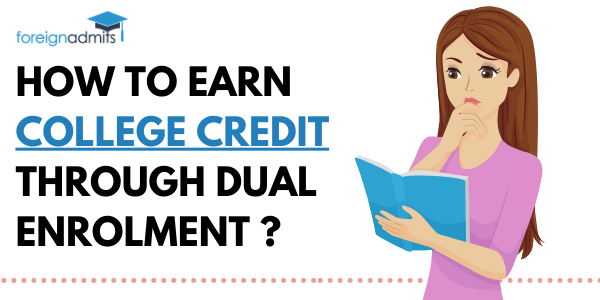What is dual enrolment?
The meaning of this work can be more often ambiguous. “Dual enrolment is a catch-all term to describe programs that allow high school students early access to college courses,” Williams says. “As such, they are partnerships between a high school or school district and accredited institutions of higher education to provide high school students the opportunity to earn transcripted college credits before they graduate high school.” Here, we shall discuss how to earn college credit through dual enrolment.
The most common meaning is that one course counts in two places. So, a student who takes a dual enrolment history class gets credit both for high school history and college history.
How does dual enrolment work?
What’s offered in one district may differ from another since partnerships can vary from school to school. Some dual enrolment programs are taught in high school, with teachers providing instruction for college-level courses. Other programs send high school students to a college campus. Sometimes college professors teach within high schools. Additionally, there are options for online instruction.
The most common method for dual enrolment is students learning within their high school from a teacher on staff who is qualified to teach college-level courses.
The number of credits a student can earn through dual enrolment is largely program-dependent. Depending on what is offered in partnership with their high school, students may earn only a handful of college credits in some programs. One can earn up to 30 credits in others and as many as 60 credits in programs aimed at helping students acquire an associate degree as part of the dual enrolment experience.
Australian National University Scholarships [Fully Funded]
Payment of Dual Enrolment
The opportunity to earn an associate degree in high school can be both personally and economically rewarding. Acquiring such a credential proves that the student is ready for college-level work and can help ease the pain of paying for college by transferring credits to a four-year school, which can halve the cost of a bachelor’s degree if 60 credits are accepted.
Given how dual enrolment price tags may differ, experts advise students to seek out their high school counsellor to get a sense of program costs.
Scholarships may also be available to cover tuition or other expenses, such as transportation and books.
How to Participate in Dual Enrolment Programs?
The participation process of dual enrolment also varies from high school to high school. Academic requirements are assessed by the high school, not the college, experts say, and the length of the program will likely determine the age at which a student can enrol.
The first step would be contacting the high school counsellor, who can explain program costs and eligibility and answer questions. Counsellors can also explain the type of programs available and the number of credits students can earn.
The 30-credit models typically start in the 11th grade. Dual enrolment is so variable that there’s not one thing that you would point to and say, ‘everybody does that.’ For example, dual enrolment does not have to, by definition, result in a degree.”
It is typically up to the high school to determine eligibility requirements to participate in dual enrolment programs.
Global Excellence Scholarship 2022 – Australia
Dual Enrolment vs Other Credit Options
Students can earn college credit in many ways beyond dual enrollment, such as taking Advanced Placement or International Baccalaureate exams or participating in the College-Level Examination Program. But colleges do not always accept all credit options.
Experts suggest that several students who want to make sure their college credits are counted toward a four-year degree should research articulation agreements. Some states have legally binding transfer agreements that require four-year colleges to honour credits earned via dual enrolment.
Generally, colleges are more likely to give credit for general education rather than specialised courses. Graduating from a dual enrolment program will also increase the likelihood of those credits being accepted.
What does Dual Enrolment Means for College Admissions?
In addition to possibly compressing time in college, participating in dual enrolment may also offer an admissions boost.
In some cases, college admissions seem to favour students with AP credits. But on the other hand, many students take AP courses and do not pass the AP exams. With dual enrolment, if you pass the college course, you have got transcripted college credit.
Experts also suggest that completing college courses shows that students are ready to leap from high school to the next level: postsecondary coursework.
“Nothing proves the ability to handle college-level work better than handling college-level work,” experts say.
GIST Scholarship in South Korea [Fully Funded]
FAQs
Here, we have answered some questions for your ease.
Q1. Is dual enrolment harder than AP?
Ans. AP may be more complex than dual, but it can be much cheaper per class. On the topics of tests and credits, one should keep in mind that the AP test has much higher stakes than a dual enrolment class. Whereas for dual, you are guaranteed college credit, as long as you pass with at least a C.
Q2. What is the difference between AP classes and dual enrolment?
Ans. You take two years of AP to receive credits for both classes, whereas in Dual Enrolment, you take these classes through CMC, so you take one each high school semester.
Q3. Does dual enrolment affect your GPA?
Ans. Most colleges recalculate your GPA when you apply, so it likely does not affect your application.
We truly hope we were able to resolve any queries you might have had about how to earn college credit through dual enrolment.
Good luck!


